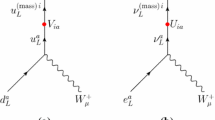Abstract
Kobayashi and Maskawa shared half the Physics Nobel Prize for 2008 for their work which incorporated CP violation in the standard model using three generations of quarks. We give an elementary discussion of this work and its importance in our understanding of the fundamental physical laws of nature.
Similar content being viewed by others
Suggested Reading
ND Hari Dass, this issue
Some of the earlier articles of interest are: Ashoke Sen, Resonance, Vol.5, No.1, p.4, 2000; Rohini M Godbole, Resonance, Vol.5, No.2, p.16, 2000; Rohini Godbole and Snnil Mnkhi, Resonance, Vol.10, No.2, p.33,2005.
M Kobayashi and T Maskawa, Prog. Thoer. Phys., Vol.49, p.652, 1973.
S Pakvasa and H Sngawara, Phys. Rev., D14, p.305, 1976.
S N Gangnli, Resonance, Vol.7, No.11, p.18, 2002.
Author information
Authors and Affiliations
Corresponding author
Additional information
Anjan S Joshipura is a Senior Professor at Physical Research Laboratory, Ahmedabad. He works on neutrino physics, CP violation and other topics which go beyond the standard model of elementary particle physics.
Rights and permissions
About this article
Cite this article
Joshipura, A.S. Broken CP symmetry and the Physics Nobel Prize 2008. Reson 14, 596–609 (2009). https://doi.org/10.1007/s12045-009-0066-9
Published:
Issue Date:
DOI: https://doi.org/10.1007/s12045-009-0066-9




